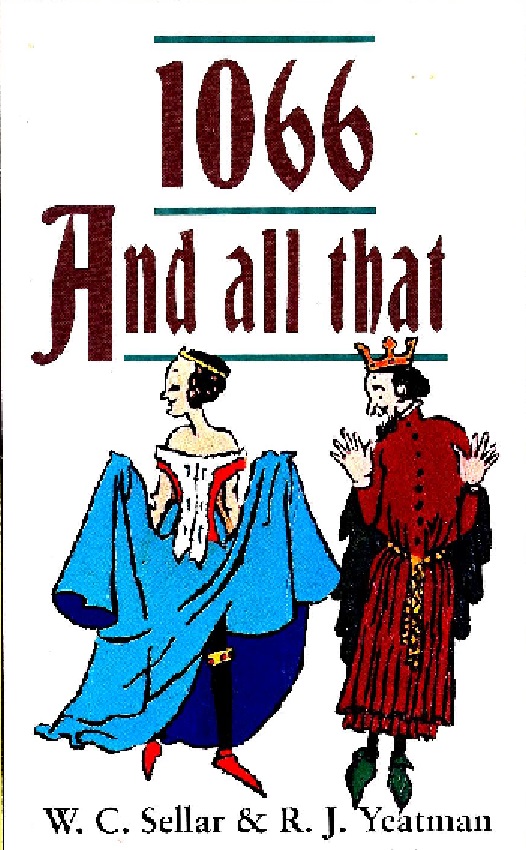(VB: The funniest thing is I could teach this to college freshmen today and they’d all believe it.)
Henry VIII was a strong king with a very strong sense of humor and VIII wives, memorable amongst whom were Katherine the Arrogant, Anne of Cloves, Lady Jane Austen and Ann Hathaway. His beard, however, was red.
In his youth Henry was fond of playing tennis and after his accession is believed never to have lost a set. He also invented a game called “Bluff King Hal” which he invited his ministers to play with him. The players were blindfolded and knelt down with their heads on a block of wood; they then guessed who the King would marry next.
Cardinal Wolsey, the memorable homespun statesman and inventor of the Wolsack, played this game with Henry and won. But his successor, Cromwell (not to be confused with Cromwell), after winning on points, was disqualified by the King (who always acted as umpire), and lost.
In the opinion of Shakespeare (the memorable playwriter and Top Poet) his unexpected defeat was due to his failure to fling away ambition.
The Restoration
Henry wanted the Pope to give him a divorce from his first wife, Katherine. He wanted this because
(a) she was arrogant
(b) he had married her a very long time ago
(c) when she had a baby it turned out to be Broody Mary, and Henry wanted a boy
(d) he thought it would be a Good Thing.
The Pope, however, refused, and seceded with all his followers from the Church of England. This was called the Restoration.
Henry’s Plan Fails
Curiously enough Henry had all the time had an idea about a new wife called Anne, who, he thought, looked as if she would be sure to have a son. So when the Divorce was all over (or nearly) her married her; but he was wrong about Anne, because she had a girl too, in a way (Elizabeth).
After this Henry was afraid his reign would not be long enough for many more divorces, so he gave them up and executed his wives instead. (* Note–All except Anne of Cleves, whom he had on approval from Belguim and sent back on discovering that she was really not a queen at all but a ‘fat mare with glanders’.) He also got less interested in his wives and gave himself up to Diplomacy, spending a great deal of his time playing tennis, etc., with the young King of France in a field called the Field of the Crock of Gold.
End of Wolsey
Cardinal Wolsey, although (as is well known) he had not thought to shed a tear about all this, did ultimately shed a memorable one. Having thus fallen from grace (indeed he had alread been discovered entertaining some Papal Bulls) Wolsey determined to make a Pilgrimage to Leicester Abbey, saying to himself, ‘If I had served my God as I have served my King, I would have been a Good Thing.’ Having thus acknowledged that he was a Bad Man, and being in due course arrived at the Abbey, Wolsey very pluckily expired after making a memorable speech to the Prior, beginning, “Father Abbot, I come to lay my bones among you, not to praise them…”
The Monasteries
One of the strongest things that Henry VIII did was about the Monasteries. It was pointed out to him that no one in the monasteries was married, as the Monks all thought it was still the Middle Ages. So Henry, who, of course, considered marrying a Good Thing, told Cromwell to pass a very strong Act saying the Middle Ages were all over and the monasteries were all to be dissolved. This is called the Dissolution of the Monasteries.
Edward VI and Broody Mary
Edward VI and Broody Mary were the two small Tudors who came in between the two big ones, Henry VIII and Elizabeth. Edward VI was only a boy and consequently not allowed to have his reign properly, but while he was sitting in the throne room everyone in the land was forced to become Protestant, so that Broody Mary would be able to put them to death afterwards for not being Roman Catholic. A good many people protested against this treatment and thus it was proved they were Protestant, but most of people decanted and were all right. Broody Mary’s was, however, a Bad Thing, since England is bound to be C. of E., so all the executions were wasted.
Elizabeth
Even though this memorable Queen was a man, she was constantly addressed by various affectionate female nicknames, such as Auroraborealis, Ruritania, Black Beauty (or Bete Noire), and Brown Bess. She also walked on Sir Walter Raleigh’s overcoat whenever he dropped it in the mud, and was, in fact, in every respect, a good and romantic Queen.
Wave of Beards

One of the most romantic aspects of the Elizabethan age was the wave of beards which suddenly swept across History and settled upon the great men of the period. The most memorable of these beards was the cause of the outstanding event of the reign, which occurred in the following way.
The Great Armadillo
The Spaniards complained that Captain F Drake, the memorable bowlsman, had singed the King of Spain’s beard (Or Spanish Mane, as it was called) one day when it was in Cadiz Harbour. Drake replied that he was his hammock at the time and a thousand miles away. The King of Spain, however, insisted that the beard had been spoilt and sent the Great Spanish Armadillo o ravish the shores of England.
The crisis was boldly faced in England, especially by Big Bess herself, who instantly out on an enormous quantity of clothing and rode to and fro on a whiter horse at Tilbury—a courageous act that was warmly applauded by the English sailors.
In this striking and romantic manner the English were once more victorious.
The Queen of Hearts
A great nuisance in this reign was the memorable Scottish queen, known as Mary Queen of Hearts on account of the large number of husbands which she obtained, e.g. Cardinale Ritzio, Boswell, and the King of France: most of these she easily blew up at Holywood.
Unfortunately for Mary, Scotland was now suddenly overrun by a wave of Synods led by Sir John Nox, the memorable Scottish Saturday Knight. Unable to believe, on account of the number of her husbands, that Mary was a single person, the Knight accused her of being a ‘monstrous regiment of women’ and after making this brave remark had her imprisoned in Loch Lomond. Mary, however, escaped and fled to England, where Elizabeth immediately put her into quarantine on the top of an enormous Height called Wutheringay.
As Mary had already been Queen of France and Queen of Scotland many people thought it would be unfair if she was not made Queen of England as well. Various plots, such as the Paddington Plot, the Threadneedle Conspiracy and the Adelfi Plot were therefore hatched to bring this about. Elizabeth, however, learning that in addition to all this Mary was good-looking and could play on the virginals (harpsichord), recognized that Mary was too romantic not to be executed, and accordingly had that done.
(From 1066 and All That by WC Sellar and RJ Yeatman, 1930, a satitical chronicle of English history from Julius Caesar, 55 BC to World War I…available at Amazon, Thriftbooks and eBay for as little as 7.00) Recommended.)





